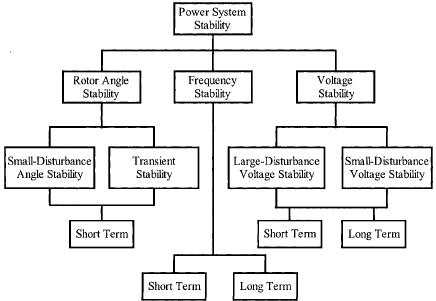What is voltage stability?
Recently lEEE/CIGRE task force [1] proposed various definitions related
to power system stability including voltage stability. Fig. 1.1 summarizes
these definitions.
In general terms, voltage stability is defined as the ability of a power system
to maintain steady voltages at all the buses in the system after being
subjected to a disturbance from a given initial operating condition. It depends
on the ability to maintain/restore equilibrium between load demand
and load supply from the power system. Instability that may result appears
in the form of a progressive fall or rise of voltages of some buses. A possible
outcome of voltage instability is loss of load in an area, or tripping of
transmission lines and the other elements by their protection leading to
cascading outages that in turn may lead to loss of synchronism of some
generators.
This task force further classified the voltage stability into four categories:
large disturbance voltage stability, small disturbance voltage stability,
short-term voltage stability and long-term voltage stability. A short
summary of these classifications is given below.
Large-disturbance voltage stability refers to the system's ability to maintain
steady voltages following large disturbances such as system faults,
loss of generation, or circuit contingencies. This ability is determined by
the system and load characteristics, and the interactions of both continuous
and discrete controls and protections. The study period of interest may extend
from a few seconds to tens of minutes.

Fig.1.1 Classification of power System stability [1]
Small-disturbance voltage stability refers to the system's ability to maintain
steady voltages when subjected to small perturbations such as incremental
changes in system load. This form of stability is influenced by the
characteristics of loads, continuous controls, and discrete controls at a
given instant of time.
Short-term voltage stability involves dynamics of fast acting load components
such as induction motors, electronically controlled loads and
HVDC converters. The study period of interest is in the order of several
seconds, and analysis requires solution of appropriate system differential
equations.
Long-term voltage stability involves slower acting equipment such as
tap-changing transformers, thermostatically controlled loads and generator
current limiters. The study period of interest may extend to several or
many minutes, and long-term simulations are required for analysis of system
dynamic performance. Instability is due to the loss of long-term equilibrium,
post-disturbance steady-state operating point being smalldisturbance
unstable, or a lack of attraction towards the stable postdisturbance
equilibrium. The disturbance could also be a sustained load
buildup.Voltage instability may be caused by various system aspects. Generators,
transmission lines and loads are among the most important components.
Generators play an important role for providing enough reactive powder
support for the powder systems. The maximum generator reactive powder
output is limited by field current limit and armature current limit. Even
though reactive power plays an important role in voltage stability, the instability
can involve a strong coupling betw^een active and reactive power.
When generator reactive capability is constrained by field current limit, the
reactive output becomes voltage dependent. The maximum load power is
severely reduced when the field current of the local generator becomes
limited. Generator limits may also cause limit-induced bifurcation when
voltage collapses occur right after the generator limits are reached [2].
Transmission networks are other important constraints for voltage stability.
The maximum deliverable power is limited by the transmission network
eventually. Power beyond the transmission capacity determined by thermal
or stability considerations cannot be delivered.
The third major factor that influences voltage instability is system loads.
There are several individual load models due to variety of load devices.
Static load models and dynamic load models are two main categories for
load modeling. Constant power, constant current and constant impedance
load models are representatives of static load models; while dynamic load
models are usually represented by differential equations [3]. The common
static load models include polynomial or constant impedance, constant
current or constant power known as ZIP models. Induction motor is a typical
dynamic load model. In real power systems, loads are aggregates of
many different devices and thus parameters of load models may be the
composite among individual load parameters. Another important load aspect
is the Load Tap Changing (LTC) transformer which is one of the key
mechanisms in load restoration. During the load recovery process, LTC
tends to maintain constant voltage level at the low voltage end. Therefore,
load behavior observed at high voltage level is close to constant power
which may exacerbate voltage instability.

 我要赚赏金
我要赚赏金

